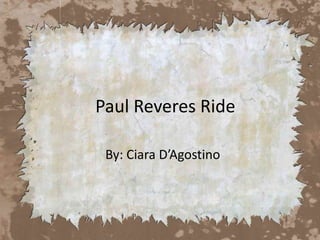
Paul reveres ride power point
- 1. Paul Reveres Ride By: Ciara D’Agostino
- 2. Introduction Nearly everyone raised in the United States knows of Paul Rever. The memory of that midnight ride has been shared by many Americans. A paradox of the American cultures is the 2 parties called the Filiopietists and the Iconoclasts and their persistence. The Filiopetists love to celebrate this midnight ride, and the Iconoclasts do not.
- 3. The Mission (Part 1) General Thomas Gage believed he had to strike at the heart of the rebel movement with as little bloodshed as possible This required secrecy, surprise, and sound intelligence. Whig leaders knew that the British army was going to move in but were not sure of where and when. They believed it was important that a British soldier must fire first.
- 4. The Mission (Part 2) The British knew the importance of intelligence. So this system was created and controlled from the top down. This proved strength in the system. But the commander in chief was normally just told what he wanted to hear instead of what was needing to be said. The American intelligence was the other way around, it was built from the bottom up.
- 5. The March (Part 1) British soldiers were ordered to move in small parties so as not to alarm the town. They made their way back to a rendezvous place on the edge of the Back Bay The chosen men were put into two elite units. The Grenadier Company men were chosen for their large size and strength The Light Infantry Company men for their agility and active men.
- 6. The March (Part 2) They spent two hours crossing the Charles River. This tidy arangement of men were the regimental pride of the British army. Once every company was in their proper positions, they received their orders to March onward.
- 7. The Capture (Part 1) Paul Revere and William Dawes traveled on their second mission that night They were overtaken by a young gentleman who introduced himself as Doctor Prescott. They rode together, and Revere explained their purpose of raising the alarm through the countryside. Revere warned the two men about the British roving squads and that they should expect to be captured.
- 8. The Capture (Part 2) Revere rode several hundred yards ahead of the men and suddenly saw two horsemen lurking under a tree in the moonlight. He shouted a warning to his companions. When they reached his side, he proposed that they attack. The group of men approached as two soldiers appeared next to the men by the tree. (Revere and his men tried to gallop away but Revere was cornered) The ambush was chosen with cunning and now Revere was surrounded by ten British soldiers with swords and pistols.
- 9. The Alarm (Part 1) Many riders joined in raising the alarm that night. Revere was thought of as a great organizer and promoter of a common effort in the cause of freedom. All along Reveres route, town leaders and militia commanders were systematically engaged in the job of raising the alarm and warning their towns.
- 10. The Alarm (Part 2) Doctor Prescott was raising the alarms in the towns west of Concord. Meanwhile his brother Abel Prescott was traveling to Sudbury and Framingham. From Needham the alarm spread east to Newton, from Dover Farms it raced to the Norfolk County then circled back towards Boston where it had originated.
- 11. The Muster (Part 1) Immediately after the alarm was received the men of Massachusetts began to assemble in their towns. John Parker was one of the leaders that men would willingly follow into the face of danger. He was an old soldier who had survived a hard campaign. He had seen more war than most of the British Regulators had.
- 12. The Muster (Part 2) The Lexington militia contained men from the age of 16 all the way up to the age of 66 (However most of them were between the ages of 30-40) This militia was the product of many years of institutional development, and was the result of careful planning and collective effort. Many towns tried to send the men out together. Other towns sent their men out in separate companies.